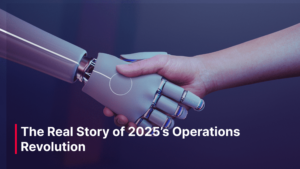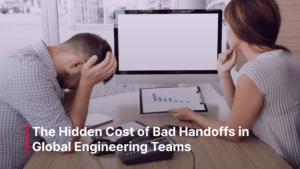What’s this operation revolution we’re talking about? Let’s take a look at the market. We’ve been talking about “digital transformation” for so long that the phrase has lost most of its punch. But this year feels different. The conversation has shifted from what technology we’re adopting to how our businesses actually run when it’s fully embedded.
From AI systems that can make operational calls without waiting for human prompts, to leadership roles built entirely around keeping transformation moving, the rules of the game are changing fast, aka a full blown operations revolution. What follows is a look at the concrete shifts, backed by hard numbers, that are quietly rewriting how the best-run companies operate.
Agentic AI: Moving from Assistance to Autonomous Execution
This year, the most forward-looking organizations are moving beyond static, prompt-based AI toward Agentic AI, systems designed to interpret business goals, coordinate multiple tools, and execute complex workflows without constant human input. The difference is stark: rather than waiting for commands, these systems act on business priorities in real time.
The operational benefits are already tangible. IBM reports automating 94% of routine HR processes, such as vacation approvals, payroll adjustments, and compliance checks, freeing up teams for strategic initiatives. And we’re seeing this trend across the board, regardless of vertical. In the financial sector for instance, UBS uses AI agents to manage high-volume client inquiries in wealth management, providing accurate responses instantly, without needing escalation to human staff, as quoted by The Economist Impact.
Automation Becomes a Long Term Investment
Global expenditure on AI, both off-the-shelf solutions and custom-built models, is projected to hit US $64 billion in 2025, nearly double the growth rate of the broader software market.
Generative AI alone is forecast to unlock US $4.4 trillion in annual corporate profits, according to Economist Impact. For companies under margin pressure this is a new path to competitive differentiation.
That scale of opportunity has also moved AI from a side-project into the core budget. CFOs and boards are now directly overseeing AI programs, with clear performance metrics and ROI timelines. In industries like manufacturing, healthcare, and logistics, leaders are shifting from pilot projects to enterprise-wide deployment, aiming to capture measurable returns within the next 12–18 months.
Transformation Leadership as a Business Discipline Indicator
Deloitte’s 2025 Chief Transformation Officer Study shows transformation budgets have jumped up to 2.5x since 2022, with the largest increases tied to technology enablement, process redesign, and talent upskilling.
48% of organizations now have a full-time Chief Transformation Officer (CTrO), up from just 2% in 2022, tasked with sustaining momentum across multi-year initiatives.
Deloitte’s data shows that investing in change management and stakeholder engagement improves transformation outcomes. Mobilizing internal champions can lift success rates by ~10%, while reducing organizational risk aversion adds another ~6%.
Beyond RPA: Intelligent & AI-Native Automation
Traditional Robotic Process Automation (RPA) automates repetitive, rule-based workflows. In 2025, forward-looking companies are adopting Intelligent Automation, RPA improved with AI models capable of handling exceptions, learning from patterns, and making context-based decisions.
Research into Generative Business Process AI Agents (GBPAs) shows they can autonomously coordinate enterprise workflows, delivering 40% faster processing, 94% fewer errors, and enhanced compliance tracking.
In insurance, Object-Centric Process Mining paired with LLMs allows real-time identification of claims process bottlenecks, drastically reducing cycle times and improving customer satisfaction.
The Emergence of AI Boutiques in the Consulting Industry
The consulting industry is seeing a rise in specialized, AI-first boutique firms. While McKinsey, BCG, and Deloitte remain dominant, smaller players like Xavier AI (strategic AI reasoning), Perceptis (AI for business development), and Keystone (operational optimization) are winning clients with faster delivery, lower overhead, and niche expertise.
These new players typically integrate proprietary AI agents into client operations within weeks, something traditional firms often need months to achieve, making them attractive to companies that need immediate operational lift – now that’s an operations revolution.
Agility in Leadership: Navigating Complex Tensions
Deloitte’s 2025 Global Human Capital Trends report highlights a growing demand for leaders who can navigate contradictions:
- Stability vs. speed in decision-making;
- Automation vs. augmentation of human work;
- Control vs. empowerment in governance structures.
This “stagility” mindset combines strong organizational anchors with the flexibility to adapt rapidly to new market and technology conditions. Leaders who excel here often set the tone for enterprise-wide innovation through this type of AI-led operations revolution.
Untapped ROI
McKinsey’s Technology Trends Outlook 2025 identifies cloud and edge computing, immersive reality, digital trust, and quantum technology as the main operational enablers for the next three to five years.
Deloitte’s Tech Trends report notes that AI is becoming as essential as electricity or HTTP, embedded into the core fabric of operations, often invisible to the end user but critical to uptime and performance.
Confidence in category management has risen from 87% in 2024 to 96% in 2025. Yet Economist Impact research shows that few organizations systematically link procurement tech investments to measurable outcomes, a gap that could mean missed ROI potential.
Prepping for a Future-Ready Operations Revolution
Operational transformation has shifted from optional to existential. Agentic AI, intelligent automation, and agile leadership are redefining how work gets done. Organizations that combine new technology with disciplined transformation governance, proactive cultures, and measurable business impact can significantly improve their performance in the upcoming years.


